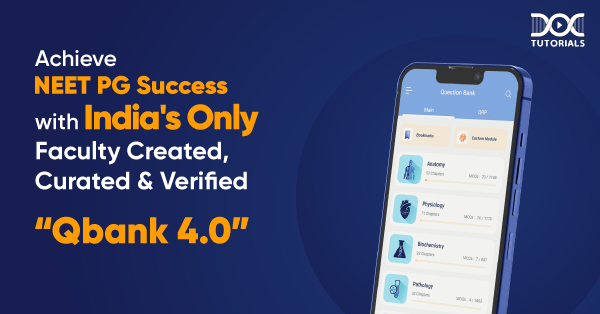
Medical college entrance exams are tough. Students get anxious even thinking about attempting them. They have to not only pass these stiff entrance exams but do so with flying colours. Those high scores and ranks are what can get them into the colleges of their choice to study the subjects they want to.
That is why students often feel the need to enroll with top-grade coaching institutes that prepare them with a solid foundation in medicine. The goal of these coaching institutes is to help students sail through these medical entrance tests with very high grades.
With the growth of coaching institutes, teaching methods for medical students have also undergone a sea change. Several new strategies, techniques, and processes are now used to make pre-college medical education more well-rounded for students.
DocTutorials (one of India’s premier medical entrance coaching institutes) has developed a 360-degree approach, using some of the latest medical education methods, to train its students for tough medical entrance exams (like NEET PG, NEET SS, FMGE, INICET, and INISS).
Let’s see what the best medical education programmes could ideally contain and what DocTutorials includes in its curricula.
At the macro level, medical teaching has become more varied in focus
Traditionally, medical education was taught using an approach that first exposed students to theoretical learning. Students listened to lectures by instructors or did lab-based practice – but it was all essentially a one-way approach from teacher to student.
This was usually followed by placing students in clinical practices (as interns) to give them a hands-on feel of actual patients with real problems to get a more balanced understanding.
According to Ausoma.org, we have several other refinements to teaching approaches today. They aim to teach students some mental and behavioural skills beyond just pure medical knowledge. Let’s review some that are generally in use and other additions that are specific to DocTutorials.
4 Medical Teaching Evolutions Shaping Medical Education at Large
1. Problem-based instruction
In problem-based teaching, the instructor usually gives students a medical problem to mull over before live classes occur. Students are encouraged to apply autonomous thinking around the complexities of the problem and see if they can find solutions either from what they already know or through independent research. Groups of students may also be encouraged to collaborate to come up with solutions before the teaching class.
Problem-focused instruction allows students to get interested in the topic sufficiently so they can get the most out of the following teaching and lectures. In this method, students are guided to develop their interpersonal skills as well as problem-solving skills.
2. Case-based instruction
In case-based teaching, the faculty may give students a specific case of some complexity, where there could be many ways to treat the patient. Students must learn how to analyse the variables and prioritise their solutions. This method aims to get students to appreciate that there could be more than one solution that works every time.
With any solution, a doctor has to consider the various advantages and tradeoffs to make an optimal choice. This teaching method helps grasp a case entirely but ultimately make a difficult choice – or a series of choices – when there are no single clear answers.
3. Inquiry-based instruction
In inquiry-based instruction, students can use their mental resources to raise the correct queries when faced with a medical situation. They have to acquire the ability to use the knowledge they have gained to know what investigation a medical scenario may require for them to be able to diagnose correctly.
The inquiry-based instruction approach develops student’s proficiency in knowing what investigative routes are available and what data they can glean from them to improve their interpretative skills. This teaching method also calls for students to stay apace with scientific or medical innovations so that their exploration options will be more comprehensive. (Yale School of Medicine has an exclusively dedicated Investigative Program PhD course – that’s how important the subject has become.)
4. Evidence-based instruction
Evidence-based instruction is one of the new approaches in medical education, where students are urged to read a lot of reputed medical journals and expert-reviewed literature (like The Lancet) – and be aware of precedents in medical practices, experiments, and cases handled successfully worldwide.
When students combine what they are taught as the foundation of medicine with what they read as evidence from across the world that supports or discards existing theories, they are on a journey of continuous learning. Tomorrow’s doctors need to cultivate this habit of constant self-enhancement because medicine is an ever-evolving and incrementing field.
9 medical teaching methodologies shaping medical education at DocTutorials
1. Multi-discipline-based instruction
DocTutorials has developed its core curricula via a Multi-Disciplinary Approach (MDA) to train its students. The idea DocTutorials believes in is this: education for medicine should have diverse components to it for a comprehensive subject understanding.
DocTutorial’s new upgraded coaching app, Version 2.023, is geared towards enhancing student’s information absorption and memorising capabilities, making them ready for the Year 2023. This V 2.023 app has enriched, immersive, and multi-disciplinary content to make it both educative and experiential.
2. Intra-faculty-discussions-based instruction
Doc Tutorials has an interesting teaching format called Integrated MCQ Discussion Videos (IMDVs). The new app features up to 70+ such IMDVs. Students can watch debates between renowned faculty members, who discuss vital topics (including New Pattern MCQs) threadbare and explore all the nuances. These IMDVs can be enlightening for students.
3. System-based instruction
One of DocTutorial’s best teaching methods is via System Based Integrated Test Series (SBITs). Students are taught to appreciate that the human body has various systems that operate in tandem, and every system needs to be mastered in depth. This method of instruction offers both a granular and a holistic grasp for students.
4. Animated-video-based instruction
DocTutorials has a collection of Video Lectures with hours of content covering a full range of 19 subjects. Advanced 2D/3D animations in these technologically superior videos offer students an experiential feel of critical topics. Students get to see how theoretical knowledge manifests as practical reality.
5. Live-teaching-based instruction
Live Sessions at DocTutorials help transfer valuable knowledge from instructors to students. These live classes are great opportunities for students to clear their doubts and queries and learn how to prepare for the Quick Revision Programmes (QRPs).
6. Test-series-based instruction
Frequent and intensive testing is one of DocTutorial’s tenets of teaching. The Test Series at DocTutorials generally includes a packed calendar of subject tests, revision tests, grand tests, and elite tests. Tests have two advantages for students. One, they help students assess their subject thoroughness regularly. Two, they get rid of any exam-related tensions among students.
7. Question-format-based instruction
The new QBank 2nd Edition from DocTutorials is a vast library – an invaluable resource – of past question papers and New Pattern additions. In its freshly reconfigured edition, it has Image Based Questions (IBQs) and 17000+ Multiple Choice Questions (MCQs).
8. Frequent-rehearsal-based instruction
Rehearsals are an intrinsic part of the syllabus planning at DocTutorials and help with meticulous preparation. Rigorous and regular Test & Discussion (T&D) sessions are held to sharpen student’s focus and skills constantly. Faculty members expose students to potential exam questions (supported by images and videos).
9. Self-assessment-based instruction
The Leaderboard at DocTutorials is a ranking table that shows students the ongoing and up-to-date results of quizzes and tests they have participated in. In this way, they can know how ready they are in their exam preparation and which areas of study they need to fortify.
In summary
DocTutorial’s coaching app V 2.023 for NEET PG students encapsulates some of the most potent medical teaching methods. Aspirants are encouraged to download, sign up, and subscribe to the app to take full advantage of its cutting-edge medical education methods. The future is already here.
Latest Blogs
-

Medical Teaching Methods Get A Boost Via DocTutorials App V 2.023
Medical college entrance exams are tough. Students get anxious even thinking about attempting them. They have to not only pass…
-

5 Top NEET PG Preparation Tips – Exclusively Made for You
NEET PG preparation is challenging for any individual, and to make it simple and easy, we at DocTutorials give you…
-

NEET PG Previous Years Question Papers, MCQs, IBQs, and High Probability Questions – Qbank 4.0
Access NEET PG previous year question papers, NEET PG MCQs, high-yield questions, and all NEET PG subjects with our Qbank…
 Back
Back